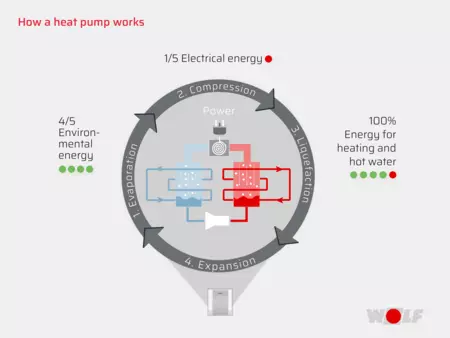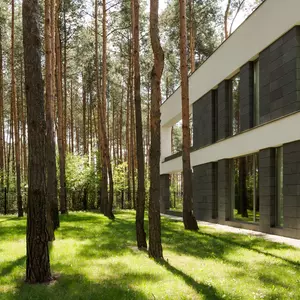
Heating of the future
Survey of heating types
Did you know that heating, hot water supply and lighting in private and commercial buildings account for around 40% of total energy consumption in Germany? These three energy consumers alone emit around 20% of the CO2 in Germany. It cannot be denied that the building sector, especially heating technology, is one of the biggest energy guzzlers and has a major influence on the CO2 emissions targets. In this article you can find out how fossil fuels and building heating are related and what heating systems will contribute to the energy transition in the future.
Regulations and funding measures
What the government says about the renewal of old heating systems
Politicians have introduced both stricter regulations with regard to building construction as well as recommendations and subsidy programs for integrating alternative heating systems. These measures have met with success, and energy consumption in the building sector has fallen significantly.
In 2012, around 30% less energy was used in buildings across Germany than in the benchmark year 1990. The fact that the average living space has increased by 17% further highlights the clear increase in efficiency.
This success is mainly based on the reduction of the heat demand through regulations that relate to insulation and the obligation to switch to modern heating systems.
But what about the climate goals in this context? The good news is that the trend clearly shows that efforts to achieve a more sustainable and efficient energy and heat supply are bearing fruit. The bad news is that Germany will still miss its climate targets for CO2 reduction in 2020.
A reduction in carbon dioxide equivalents from 906 million tons in 2016 to 751 million tons is unrealistic. Not least because of this, private consumers are also asked: What contribution can each individual make in their own home to heat in a more environmentally friendly way?
Fossil fuels for the generation of heat
One thing is certain: fossil fuels are and will remain part of private buildings in Germany. In particular, gas occupies an enormous place in the heating structure with almost 50%.
Current developments show that the heating transition is a process that is only progressing gradually.
In existing housing
The table shows that around three quarters of all German households heat with fossil fuels such as gas and oil. More sustainable technologies such as heat pumps and district heating are on the rise, but even less relevant for existing housing.
If we take a look at the heating structure in new apartments, we can see major progress towards environmental friendliness.
It is gratifying that alternative concepts such as district heating, heat pumps or the combustion of renewable raw materials were taken into account as energy sources in more than half of the newly installed heating systems.
In addition, numerous outdated boilers were replaced by more efficient, modern condensing boilers, which also has an impact on the energy efficiency of heating.
Heating of the future: This solution is available now
Heating with solar thermal energy
Solar thermal energy works on the basis of the heating of water by the sun. There are collectors on the roof of a building through which water flows. Sounds easy? Right!
This is precisely why this technology is so widespread and popular in Germany: in 2017, over 2 million such solar thermal systems were in use on German roofs.
A useful addition to the solar system is a buffer cylinder that stores the heat energy captured. Conventional oil or gas boilers or heat pumps are also used alongside or instead of such a measure.
Solar energy is used efficiently when the sun is shining, whereas the other part of the heating covers the heat demand on days without sunshine and at night.
Pros & cons at a glance
1) Pros
- Solar energy does not cost anything and is available in unlimited quantities
- Good combinability with other forms of energy
- Financial incentives from the state
- Investment costs decrease with technological progress
2) Cons
- Dependency on hours of sunshine
- Solar collectors alone usually do not cover the entire heating requirement of the building
Heat pumps
Heat pumps are primarily suitable as the heating method of the future for modern, well-insulated buildings of high construction quality. The lower the temperature level required for heating, the better the heat pump works – i.e. the more efficient and environmentally friendly its performance.
German households consume an average of 6,000 kilowatt hours of electricity annually with a heat pump. With a good provider at hand, you can get away with relatively cheap electricity costs.
Even better, you can also generate the electricity for your heat pump yourself using a photovoltaic system.
Pros and cons at a glance
1) Pros
- High level of environmental friendliness by avoiding fossil fuels
- Can be easily combined with photovoltaics
- Low maintenance costs
- Environmental energy does not cost anything and is available in unlimited quantities
2) Cons
- Relatively high investment costs
- Dependent on fluctuations in electricity prices
- Depending on the type, approval is required

Hybrid heating
Hybrid heating combines different heating systems: gas or oil work together with renewable energy sources. The big advantage is that the strengths and weaknesses of different systems work together so that the good properties of one heating system compensate for the bad properties of the other energy source. Also practical: your heat supply does not depend on one heating system alone.
The focus of hybrid heating is on the heat and buffer cylinder, which stores excess heat energy from various sources. If the temperature in the storage tank falls below a certain value, the gas or oil heating continues to generate heat – in an environmentally friendly and reliable manner.
1) Pros
- Combination of oil heating, gas heating and renewable energy sources
- Environmental friendly functionality
- Independent heat generation
- Installation of a basic system with flexible expansion options
2) Cons
- High purchase costs
- Complex installation
- Different heating systems require a lot of space
Conclusion
One thing is certain: the heating of the future needs to work more efficiently and generate lower fuel costs than conventional heating. Compared to conventional systems, overall lower energy costs can be assumed.
Another plus point is that the state frequently offers financial support for the refurbishment of heating systems. Depending on which heating system you choose, your investment can pay for itself after just a few years.
Not to be overlooked is that you are making a valuable contribution to environmental protection by choosing renewable energy sources to generate heat. We recommend that you seek advice from a specialist who can take your individual needs and circumstances into account and advise you on a specific heating system for your home.


